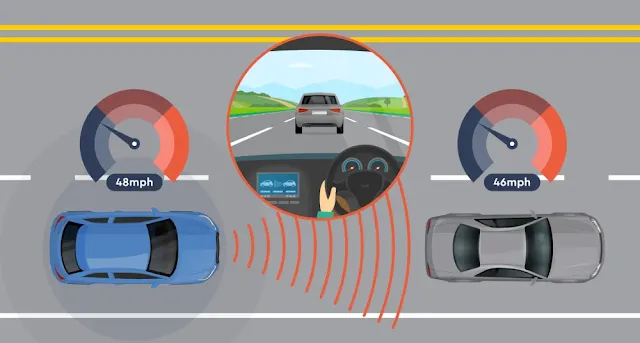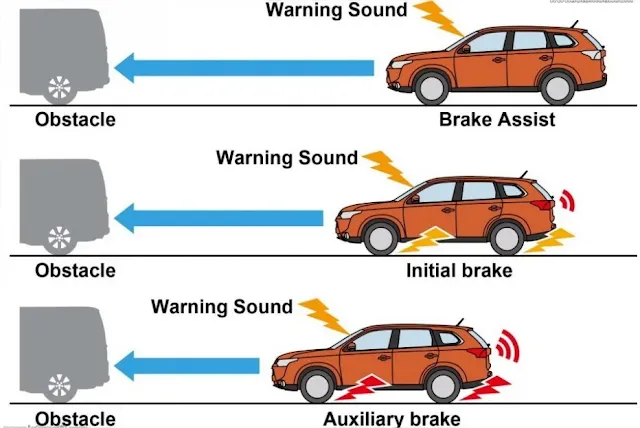Advance Driver Assistance System in Car
Description about ADAS system in Car:-
Advanced Driver Assistance Systems (ADAS) is a set of safety technologies that use sensors, cameras, and other advanced technologies to assist drivers in operating their vehicles safely. ADAS can help detect potential dangers on the road and provide warnings or automatic actions to prevent accidents.
Some examples of ADAS system in Car:-
1. Adaptive Cruise Control (ACC):
ACC uses sensors to detect the distance between the vehicle and the one in front of it. It automatically adjusts the speed of the vehicle to maintain a safe distance and can bring the vehicle to a complete stop if necessary.
2. Lane Departure Warning (LDW):
LDW uses cameras to detect when a vehicle is drifting out of its lane. It provides an audible or visual warning to the driver to take corrective action.
adas-system-in-car
3. Blind Spot Detection (BSD):
BSD uses sensors to detect vehicles in the blind spot of the driver. It provides an alert to the driver if they attempt to change lanes when there is another vehicle in their blind spot.
4. Collision Avoidance System (CAS):
CAS uses radar, cameras, or other sensors to detect potential collisions with other vehicles, pedestrians, or objects. It provides an audible or visual warning to the driver and can also apply brakes or steering to avoid the collision.
5. Parking Assistance System:
This system uses cameras and sensors to detect obstacles and provide a real-time view of the surroundings. It assists the driver in parking the vehicle safely and accurately.
adas-system-in-car
Overall, ADAS technologies can help reduce the risk of accidents, save lives, and make driving a safer and more enjoyable experience.
Working of ACC (Adaptive Cruise Control) system in Car:-
Adaptive Cruise Control (ACC) is an Advanced Driver Assistance System (ADAS) feature that uses radar sensors and cameras to detect the distance between the driver's vehicle and the vehicle in front of it. ACC maintains a safe distance between the two vehicles by automatically adjusting the speed of the driver's vehicle.
Working of ACC:-
1. The driver sets the desired cruising speed on the vehicle's dashboard or steering wheel controls.
2. The radar sensors and cameras located at the front of the vehicle detect the distance between the driver's vehicle and the vehicle in front of it.
3. The ACC system then calculates the safe distance between the two vehicles and automatically adjusts the speed of the driver's vehicle to maintain that distance.
adas-system-in-car
4. If the vehicle in front of the driver's vehicle slows down or comes to a stop, the ACC system will also slow down or come to a stop accordingly.
5. Once the road ahead is clear, the ACC system will resume the set cruising speed.
6. Most ACC systems also have customizable settings that allow the driver to adjust the following parameters:
a. Following distance: the distance between the driver's vehicle and the vehicle in front of it.
b. Speed range: the maximum speed at which ACC will operate.
c. Sensitivity: the level of sensitivity of the system's detection of the vehicle in front.
Adaptive Cruise Control can help reduce driver fatigue, improve fuel efficiency, and enhance safety by automatically adjusting the vehicle's speed in response to traffic conditions. However, it's important for drivers to remain alert and attentive while using ACC, as the system is designed to assist drivers, not replace them.
Working of LDW (Lane Departure Warning) system in Car:-
Lane Departure Warning (LDW) is an Advanced Driver Assistance System (ADAS) feature that uses cameras to detect lane markings on the road. The LDW system alerts the driver if the vehicle drifts out of its lane without signaling.
Working of LDW:-
1. The camera installed on the vehicle detects the lane markings on the road.
2. The LDW system analyzes the camera's input and determines the vehicle's position relative to the lane markings.
3. If the vehicle starts to drift out of its lane without signaling, the LDW system will activate an alert. This can be an audible alert, a visual alert, or both.
adas-system-in-car
4. The driver can then take corrective action to steer the vehicle back into its lane.
5. Some LDW systems also include haptic feedback, which provides a physical alert to the driver, such as a vibration in the steering wheel or seat, in addition to the audible and visual alerts.
It's important to note that LDW is designed to assist the driver and not replace them. Drivers should always remain attentive and keep their hands on the steering wheel while driving. LDW is just one of the many ADAS features that can help improve safety and prevent accidents on the road.
Working of BSD (Blind Spot Detection) system in Car:-
Blind Spot Detection (BSD) is an Advanced Driver Assistance System (ADAS) feature that uses sensors to detect vehicles in the driver's blind spot. The BSD system provides an alert to the driver if they attempt to change lanes when there is another vehicle in their blind spot.
Working of BSD:-
1. BSD uses sensors, typically located in the rear bumper, to detect the presence of other vehicles in the driver's blind spot.
2. The BSD system monitors the vehicle's blind spots and activates an alert if it detects a vehicle in the driver's blind spot.
3. The alert can be visual, such as a warning light in the side mirror or on the dashboard, or audible, such as a chime or beep.
adas-system-in-car
4. The driver can then take corrective action, such as waiting until the vehicle has passed or checking the blind spot manually before changing lanes.
5. Some BSD systems also include Rear Cross-Traffic Alert (RCTA), which detects vehicles approaching from the side while the driver is backing up, and provides an alert to the driver to prevent collisions.
Blind Spot Detection can help drivers to avoid dangerous lane changes and prevent accidents, especially on highways or in heavy traffic. However, it's important for drivers to remain alert and attentive while using BSD, as the system is designed to assist drivers, not replace them.
Working of CAS (Collision Avoidance System) in Car:-
Collision Avoidance Systems (CAS), also known as Forward Collision Warning (FCW) and Automatic Emergency Braking (AEB), are Advanced Driver Assistance Systems (ADAS) designed to help prevent or mitigate collisions with other vehicles or obstacles on the road.
Working of CAS:-
1. CAS uses radar, lidar, and/or cameras to detect the distance and relative speed of objects in front of the vehicle.
2. The system analyzes this information to determine if there is a potential collision risk.
3. If the system detects a potential collision, it will first issue a warning to the driver through an audible or visual alert.
adas-system-in-car
4. If the driver fails to respond and the system determines that a collision is imminent, the system will automatically apply the brakes to reduce the speed of the vehicle or bring it to a complete stop.
5. Some CAS systems also include pedestrian detection and can detect pedestrians or cyclists in front of the vehicle, providing additional warnings or braking assistance.
CAS can help reduce the severity or even prevent collisions altogether, especially in situations where the driver may be distracted or unable to react quickly enough. However, it's important for drivers to remain attentive and engaged while using CAS, as the system is designed to assist drivers, not replace them. It's also important to note that CAS technology varies between different car manufacturers and models, so the specific functionality and performance of the system may differ.
Working of PAS (Parking Assistance System) in Car:-
Parking Assistance System (PAS), also known as Park Assist, is an Advanced Driver Assistance System (ADAS) that helps drivers park their vehicle by providing guidance, alerts, and in some cases, automatic steering.
Working of PAS:-
1. PAS uses sensors located around the vehicle, including ultrasonic sensors or cameras, to detect the presence of obstacles around the car.
2. When the driver engages the parking assistance system, the sensors scan the surrounding area and send information to the PAS computer.
3. The PAS computer processes the information and provides visual or audible feedback to the driver, indicating the position and distance of obstacles.
adas-system-in-car
4, Some PAS systems also provide steering guidance, helping the driver to steer the vehicle into a parking space while the system controls the speed and direction of the vehicle.
5. In some advanced PAS systems, the vehicle can even park itself with little or no input from the driver.
PAS can help make parking easier and safer, especially in tight spaces or busy parking lots. However, it's important for drivers to remain aware and engaged while using PAS, as the system is designed to assist drivers, not replace them. It's also important to note that PAS technology varies between different car manufacturers and models, so the specific functionality and performance of the system may differ.
So friends, if you like this article please share with your friends and support us. Thanks.....








.webp)
.webp)

0 Comments